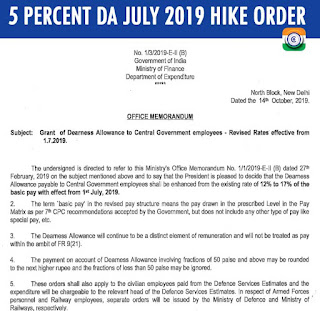KVS
F.11054/2/2017/KVS(H)/RPS
Dated: 16.04.2018
NOTICE
Kendriya Vidyalaya Sangathan has conducted the written
Examination for the post of Lower Division Clerk from
19th February, 2018 to 23rd February, 2018 in various
shifts. In preperation of result of written examination
for the post of LDC, Score Normalization Method has
been adopted by KVS. The formula of Score Normalization
Method is placed below.
sd/-
(TAJUDDIN SHAIK)
Assistant Commissioner (RPS)
(TAJUDDIN SHAIK)
Assistant Commissioner (RPS)
Score Normalization
About NormalizationNormalization means adjusting values measured on different scales to a notionally common scale.
Need for Normalization in Exam
Exam pertaining for a particular post/course could be spread across multiple shifts which will have different question paper for each shift. Hence the normalization of scores need to be carried out for all the candidates who had written the exam, across shifts for the same post/course.
Normally, after the exam, candidates are provided a window of few days, post the publishing of question paper and the correct keys. Based on the objections raised, SMEs work on that and with customer consultation finalize to ignore some objected questions and the remaining questions will be considered for score evaluation and subsequently the score normalization.
Inputs required for score normalization process
1. Raw score report of the candidates who appeared for a particular post, across all shifts.
2. The actual number of valid questions to be considered, post the objection
Score Normalization logic
The following has to be calculated across all shifts for all the candidates who have written the exam for the same post.
Total Number of Questions (A)
Defined as the number of questions available in the question paper. (e.g. 120 questions)
As an example, ASSUME the question papers has 120 questions
Total Number of Correct Questions (B)
Defined as the number of valid questions which have to be considered for score evaluation and score normalization, post the finalization of questions after the candidates have raised objections (if any)
B = A – # questions which are removed post candidate objections
ASSUME there are 3 invalid questions in (A)
Then B = 120-3 = 117
Example: ASSUME a candidate has attempted 103 out of 117 questions, of which 98 are correct responses and 5 are wrong resonses. 14 un-attempted questions will be Blanks.
Total Correct Responses (C)
Defined as the number of responses which are answered correctly by the candidate for the total number of valid questions (B)
In the example C = 98
Candidate Score (D)
Total Correct responses (D)
In the example D = 98
Candidate Score to be considered for Normalization (E)
Consider the case where scores will be based on 120. So, score (D) of every candidate is to be prorated i.e. it has to be multiplied by the factor: 120/B
In the example E = (D/B)*100 = (98/117)*120 = 120 = 100.5128205
Now we need to calculate Average and Standard Deviation for each Shift
Calculation of Standard Deviation Example : 9 candidates attended a shift
Xav is the average which is total marks divided by no. of candidates
| D or X (raw score for 120) | X = (X-Xav) | x² | |
| 1 | 31 | -34 | 1156 |
| 2 | 46 | -19 | 361 |
| 3 | 40 | -25 | 625 |
| 4 | 71 | 6 | 36 |
| 5 | 65 | 0 | 0 |
| 6 | 90 | 25 | 625 |
| 7 | 59 | -6 | 36 |
| 8 | 84 | 19 | 361 |
| 9 | 99 | 34 | 1156 |
| N = 9 | Total = L = ∑X = 585 | ∑ x² = 4356 |
Xav = : L /No. of candidates present for that particular shift = 585 / 9 = 65
Standard Deviation = square root of ∑x²/N = square root of 4356/9 = square root of 484 = 22
Total Raw Scores for all candidates in a shift (L)
Sum of Raw candidates raw scores (X) for all candidates in a shift
L = ∑X
In the SD example L = 585
Simple Average (Xav)
Total Raw score for all candidates in a shift (L) / Total candidate (Present) count for a shift
= L /N
Standared Deviation (S)
Calculated at a shift level bases on the candidate’s scores
To be calculated as explained in the example
Normalized Score for each candidate (Xn)
Xn = (S2/S1) * (X-Xav) + Yav
| S2 | Is the SD of the shift with the
Highest Average Score taken as base for normalization |
| S1 | Standard Deviation for the
corresponding shift (to be scaled to S2) |
| x | Raw score of a candidate |
| Xav | Simple average of the Shift |
| Yav | Average corresponding to shift with
highest Average (taken as base for normalization) |
Criteria for choosing the base for normalization is generally taken as the shift with 'Highest Average' of raw scores. Only exception is made if this shift (with highest average) has far less number of candidates as compared to other shifts. In that case we take the next shift with 'highest Average' as base for normalization.
70% of the average attendance is the limit. Any value below this should not be considered for the base. (This percentage can be set to any value)
Source: http://kvsangathan.nic.in











0 comments:
Post a Comment